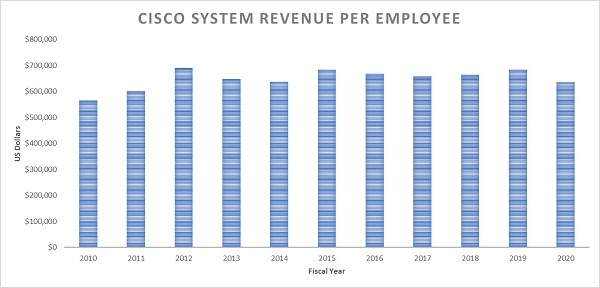For some time, I have thought that Cisco should consider selling off its collaboration business unit or spinning it out to become an independent company. This thought first came to me when Cisco began investing heavily in Spark, for team collaboration, while diminishing investment in CUCM, Jabber, HCS, and Webex.
Let’s be frank: Cisco’s business model requires premium pricing. As shown in the chart below, Cisco is very skilled at generating a lot of revenue per employee.
Cisco has had good success in buying, building, integrating, and trying to make new markets, including the collaboration (VoIP/telephony) market. But when Cisco can’t get premium pricing, it either sells the business, spins it off, or shuts it down (
Linksys,
Flip video camera,
set-top box business,
Accompany, etc). This is normal and healthy. But, now it is time for Cisco to look at the collaboration market closely, evaluate its assets, and make some hard calls.
Management Turnover
One of the troubling aspects of Cisco’s collaboration business has been the recent management turnover.
Rowan Trollope arrived in November 2012, and his big contribution was the development of Spark, which eventually became Webex Teams. Rowan left in May 2018.
Amy Chang took over as the collaboration business leader at that time, when Cisco purchased her company, Accompany. Accompany used AI to build databases of people and relationships. Amy’s contribution was to move the Accompany technology and know-how into Webex in an initiative that became known as Cognitive Collaboration (which we no longer hear anything about). Amy is an awesome human being, generous and kind; she took a leave of absence this past March to spend more time with family. But collaboration revenues also fell 8% in the quarter prior to her departure.
When she left, Sri Srinivasan then took the helm of Cisco Collaboration. Sri was extremely helpful as Webex utilization spiked during the COVID-19 crisis; his teams and leadership helped Webex cope with the extreme growth the meeting service experienced in March, April, and May. Sri then took his own leave of absence in June; Javed Kahn stepped in as the interim head of collaboration at that time, and he still runs this business — although he now reports to new hire Jeetu Patel, who joined Cisco in June after serving as chief strategy officer and SVP at Box. Jeetu reports directly to CEO Chuck Robbins, and is responsible for Collaboration, Security, and Applications.
A Massive Acquisition Amidst Executive Disruption
Amid this management change, Cisco engineers and product managers have been working to integrate the cloud telephony assets from BroadSoft, acquired in February 2018, into the Webex portfolio. Among other product lines, BroadSoft sold its BroadWorks telephony software to communications service providers (CSPs), which in turn used the software to provide cloud calling to their own customers.
While this acquisition made sense given that the telephony engine in Spark was inadequate and Cisco needed its own multitenant cloud telephony solution, I believe that integrating BroadWorks has been more difficult than Cisco anticipated. In addition, all kinds of business “hairballs” still remain from the BroadSoft acquisition. What Cisco needed was a solution that would compete successfully with RingCental (the Wall Street darling of the cloud UC providers) for small and mid-sized businesses, as well as a cloud-based telephony solution that large enterprises could consume as a service (Cisco UCM Cloud is not the right choice for all large enterprises).
Spark Calling has since morphed into Webex Calling, based on BroadWorks. However, BroadSoft had over 600 CSPs using its cloud telephony software, and since Cisco doesn’t want to alienate these providers, it continues to offer cloud telephony software to them. These providers package it up and sell it with other services, even non-Cisco services, including third-party collaboration clients. It’s sort of a migration challenge, and sometimes the messaging has been cloudy.
Further exacerbating the issue is that Cisco wants to maintain its stance of selling primarily through partners. So, Cisco VARs can also resell Webex Calling services and join them up with a service provider for PSTN access. One of the drawbacks of this business model, in my opinion, is that to get access to Webex Calling, customers must go through a Cisco CSP or VAR partner: They can’t even buy-to-try Webex Calling directly from Cisco, or from any partner’s website, like they can with RingCentral, 8x8, Zoom Phone, Microsoft Phone System and Business Voice, etc.
Sell or Spin Off Cisco Collaboration?
So, here we are with Cisco in the middle of several transitions: a management transition, a technology transition, and a collaboration market in transition. What to do? Revenues have been impacted, and there is a
billion-dollar restructuring cost-cutting initiative occurring within Cisco.
Some years ago, when people wanted to meet remotely, they would say, “Let’s do a Webex meeting.” Today, hardly anyone says that. Most often they say, “Let’s do a Zoom meeting.” By focusing too hard on the large enterprise space, Cisco has taken the Webex brand and vernacular completely out of the vocabulary and consciousness of the masses.
Furthermore, Cisco has indicated that collaboration sales historically provided a big pull effect due to the adjacency with switches, routers, security, and other Cisco products, with the pull multiplier being between three and seven times the value of the collaboration sale (primarily CUCM). I believe the adjacency effect collaboration solutions provide to Cisco has diminished significantly in recent years. When enterprise networks had to be designed specifically to handle IP voice and video traffic, the adjacency with Cisco enterprise switching gear was strong; now, someone moving to Microsoft Teams or Zoom or some other competitor does not need to worry as much about the underlying network since most networks (both enterprise and service provider) handle real-time communications reasonably well.
Cisco is recognizing the pricing pressure on collaboration by significantly
reducing the costs for Webex Calling and Meetings in its enterprise agreements (EAs). However, if we look at EAs… who buys them… primarily large enterprises.
What Can Be Done?
Here are some things Cisco might consider doing:
1. Spin off its collaboration and contact center assets into a separate entity/company.
2. With the spin-off, rebrand Webex, since that name has lost some of its luster, and relaunch it to the market.
3. Sell off CUCM or focus on using it as a bridge to cloud-based calling, but end of life it. Webex Calling is presently targeted toward SMBs, but there is no technical reason why it won’t support larger enterprises. If the new entity wants higher valuations, sticking with on-premises solutions is likely not a successful long-term strategy even if these solutions are licensed on an annually recurring revenue model.
4. Eliminate the confusion and partner competition in the market by bringing all BroadSoft-related operations in-house. This means eliminating BroadWorks sales to service providers… if CSPs and VARs want to offer a solution, it should be Webex Meetings and Calling (under the new brand), hosted and managed by Cisco (or the new entity). This would do three things:
- Make any Cisco cloud-based meetings or calling solution consistent worldwide.
- Eliminate competition with the partners.
- Enable the new entity to have the stock multipliers RingCentral and Zoom are receiving by offering a fully hosted/managed solution it owns and fully operates.
This would be similar to what Microsoft did with Exchange and Office 365: Microsoft brought Exchange hosting in-house through Office 365, and the many service providers that offered Exchange-based email had to adapt or die; plus, Microsoft provides a global, consistent Office 365 experience that includes hosted Exchange. Others can resell Office 365, but it is hosted by Microsoft and provides a consistent experience.
Cisco should do the same with any solutions based on BroadWorks: Bring the operation in house, create a consistent service, and provide a consistent brand. I think the company is trying to get here, but it is taking longer than I had anticipated it would. Bite the bullet and do it. Spinning off Webex into a separate entity would allow the new entity to sell directly.
5. Make Webex Calling available on the website for direct purchase. You can’t even buy and try Webex Calling without the overhead of going through a partner. Make it easier to procure.
6. Webex is too focused on large enterprises. Although Webex has tons of options and controls, these make it quite complicated to set up and manage. The new Webex Control Hub helps, but it is still complicated, and even in Control Hub, you branch to different back-end systems (under the covers) for telephony set-up and management. Make Webex easier to provision.
7. Collapse the offering into a single solution; this would mean combining Webex Meetings, Webex Teams, and Webex Calling into one product. Cisco has talked of a unified client for a while, and I would suggest that it is time to make one offering. This would more closely align Webex with Microsoft Teams, Zoom, RingCentral, etc., all of which have a single interface with functionality surfaced based on the service plan you buy.
8. Lower the price. While the Webex at Work pricing at $20 is competitive with Zoom, for most other offers, Cisco is more that the Zoom bundle and Microsoft Teams is cheaper than Webex for many organizations, based on the pricing analysis Phil Edholm, of PKE Consulting, and I did for our recent Enterprise Connect Digital Conference
seminar on Cisco vs. Microsoft vs. Zoom.
As I mentioned, a Cisco-branded product or service needs to be able to demand a premium price. I do not believe Webex Meetings and Calling can demand this pricing in the current and future collaboration market, and Cisco may want to consider a divestiture of some kind: either selling the assets or spinning them off into a new independent entity.
Editor's note: Brent shares more insight on this topic in a one-in-one video interview with Eric Krapf, No Jitter publisher and GM of Enterprise Connect. This is the first of a weekly series we're calling No Jitter Focus. Tune in here.










